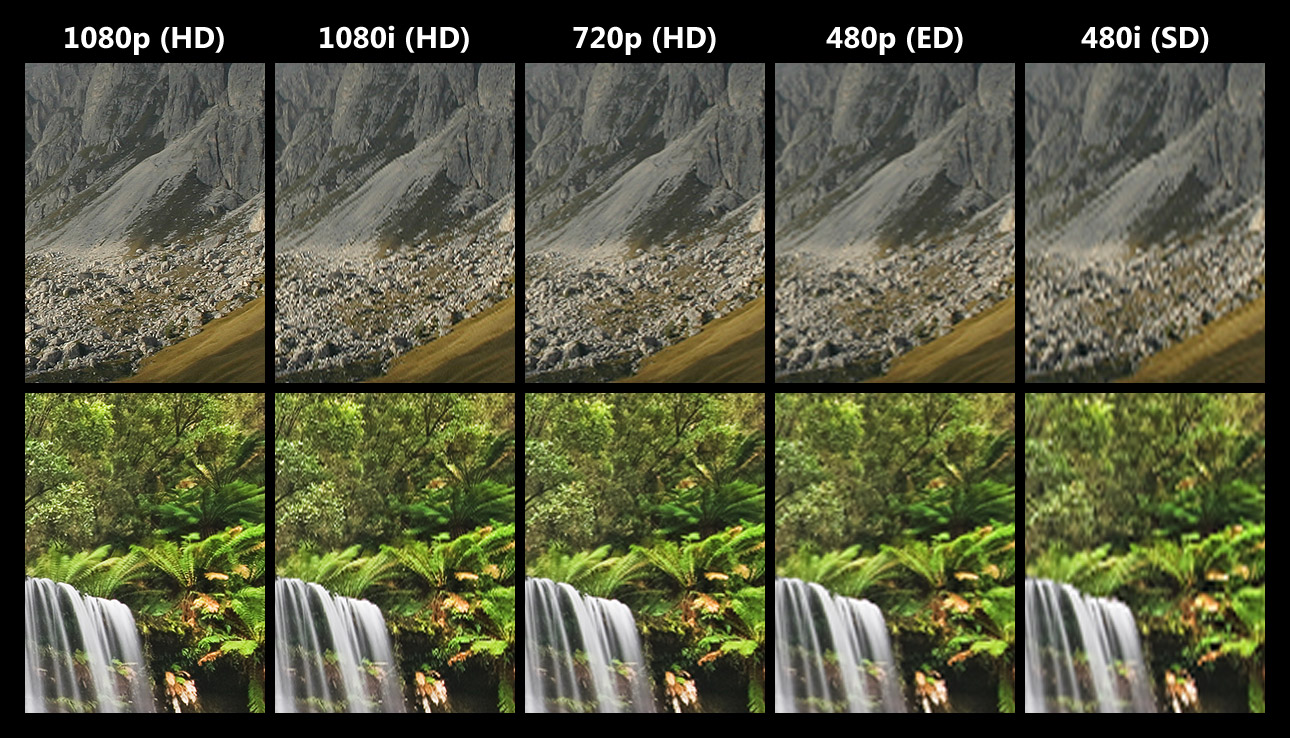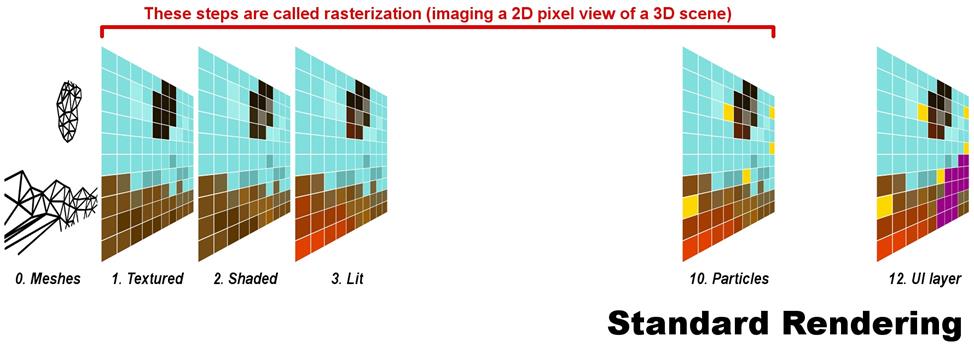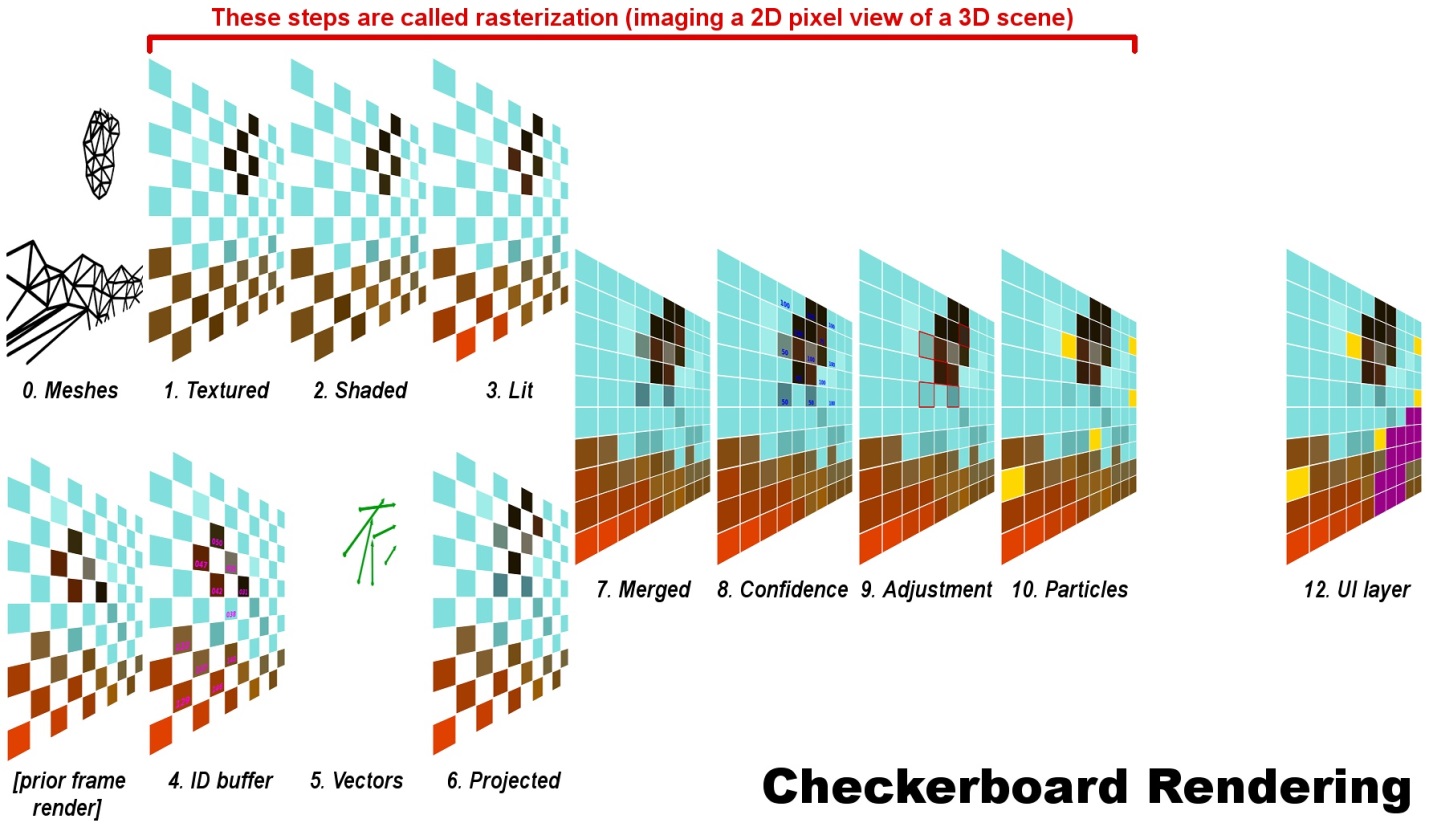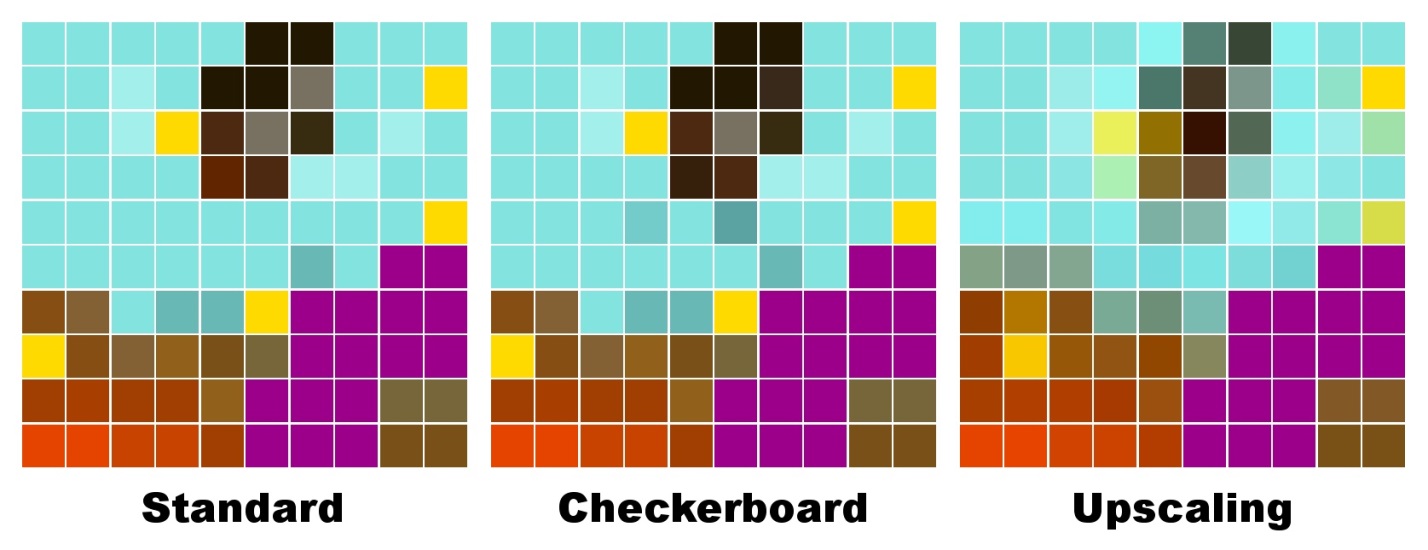Quality and scaling of the digital image. Comparison, myths, methods and economic feasibility
In the modern world there is a huge variety of various quality image gauges. An inexperienced and unenlightened person can easily become entangled in a variety of highly specialized terms, get into the tricks of marketers or thoughtlessly deprive themselves of the next technological innovations.
This article will allow you to understand most of the significant characteristics, independently compare different technologies and tweaks, as well as decide which device you need depending on the requirements and economic wealth.
FPS is a dynamic image indicator (not static), representing the number of frames per second.
Currently, cinema and television uses a long-established rate of 24 frames per second (previously, at the time of silent films, the standard was 16 frames). There are exceptions, namely:
The norm of 24 frames was born for a reason, it is sufficient for visible smoothness of the image (any movements), and it also remains easy to produce, because any change will greatly increase the width of the film. Those. This is a kind of compromise in the modern film industry, only a few of whom decide to leave.
Naturally, the larger this indicator, the smoother the image. You can demonstrate the difference with the simplest gif, in which the ball rolls from the left to the right in the same time.

As can be seen from the GIF, the difference is noticeable on any not even prepared look. Yes, the difference is not huge, but the fact that the smoothness of the image directly depends on the frame rate, I think, is obvious to everyone.
There is also a trick called frame interpolation. Such a system is used to create fan reprints, as well as it is built into some TVs. Its essence is to calculate new additional frames from source frames, that is, between 2 neighboring source frames, the program draws new ones based on motion data from neighboring ones. This system is extremely quite complex in execution, and most importantly, creates from itself a lot of artifacts that interfere with viewing.
In the gaming industry, the rate of the number of frames differs markedly from the movie. 30 frames per second - an established standard for comfortable gameplay, but the variations here are much more. Sports simulators, fighting games, first-person shooters and cyber multiplayer genres, where the reaction speed is crucial, should preferably have 60 frames per second. To achieve these indicators is often difficult, because FPS is directly dependent on system performance.
Modern informative space has generated many myths about the frame rate, each of which I would like to consider.
This myth was born, most likely because of the standard of the film industry, but, most importantly, it is fundamentally wrong.
Absolutely everything is capable of seeing a frame rate difference exceeding 24, which you were convinced of in the already shown gif. Another thing is the question of whether the brain is able to recognize the information shown at high speed. Here, not everything is so simple, but studies have shown that with proper training, a person is able to see the difference in the picture, which flickered only in one frame of all.
This myth was born in 1957, when an American scientist published a study during which sales of popcorn were allegedly increased by the consequence of 25 frames. After 5 years, he admitted that he completely fabricated the experiment. In spite of this, the myth is still alive, and on the Internet you can find a lot of videos and sites that offer the effect of 25 frames for money (slimming, learning languages, etc.).
There is no effect, much less an effect on the mind. Otherwise it would mean that absolutely every game, or the same Hobbit of Jackson, every second would have the opportunity to process your brain with hidden information. What, obviously, well, quite stupid in its pure form.
Resolution is an indicator of the image, directly indicating its quality, representing the number of points (or pixels) per unit area (or unit of length).
In the modern technology race, this indicator is most familiar to every ordinary buyer of equipment. Any electronics store is replete with all kinds of advertising signs “Full HD”, “Real 4K Resolution!”, “Crystal-clear picture”, etc.
Far from being simple, this is the most important indicator of any device for reproducing visual information, be it a laptop monitor, a TV screen, a smartphone display or an e-book. The higher the resolution, the cleaner and more detailed the picture. The progress of the picture is obvious, it is worth just what kind of image we saw at the time of VHS, well, or take a look at the simplest comparison:

Image quality also depends on its source, the speed of development of which is completely different. And at its head is the gaming industry, which every day constantly increases the technological aspects. Game industry does not sleep. It is she who is pushing the progress of image quality development more than anyone else. Generation consoles, improved system performance - everything leads to the fact that the picture becomes more realistic, clearer and more detailed.
When the fashion for 3D-TVs quickly went out, but its place came another technological aspect - 4k screen resolution, advertised from all sides.
Most likely, all of you for the most part are at home Full HD TV. Do you need to move to a new resolution? Will you see the difference?
It all depends on what you are going to use it for. This resolution is still rare. Modern television, especially in our country, is mostly broadcast in the meager oldest 480p (720x480 pixels), only a few channels, and sometimes for a fee, switched to HD (720p), and only a couple on FHD (1080p), for example, "First channel". This means that if you use the TV only for its intended purpose, 4k resolution in this decade you will not see for sure.
In order to at least somehow use the capabilities of the new resolution, you will need to either buy 4k blu-ray discs with movies (which is still not widespread and, most importantly, expensive), or look for 4k streaming services (ala Netflix , which, although it exists officially in Russia, does not provide localization of any of its creations), or watch 4k videos on YouTube (the number of which is extremely small so far), or use for gaming purposes in conjunction with a high-tech device, such as Xbox One X or Ps4 Pro. But in the latter case, you will not always be able to use all the features of such a TV. There are many tweaks (ways) that developers use, because the technical component is still not fully suitable for new-fashioned resolution.
All variations of the final resolution are:
Native resolution is the real (pixel to pixel) resolution of the source that matches the display device (4k in our case).
It is this resolution that uses Netflix and 4k video on YouTube, but in the gaming industry it is difficult to achieve it. On such a picture you need expensive equipment, the power of which may still not be enough for a stable frame rate.
Naturally, it is this resolution that gives the best picture, while the use of tweaks, such as chess rendering, degrades clarity. This is especially evident in the distance drawing at 4-fold approximation for comparison. As an example, take a 4-fold multiple approximate screenshot of two versions of the game (native 4k resolution is on the left, dynamic resolution with chess rendering is on the right) from the excellent Digital Foundry channel comparing the Rise of Tomb Raider game.

Since 4k TVs and monitors are still not very common (especially in Russia, where even half of the population has not switched to HD), and their prices are high, there is a contingent of people with only the FHD screen, but with more productive modern device. Of course, any user wants to get the most from the capabilities of the new technology. For this and there is technology supersampling.
Supersampling is a technology, as a result of which the picture in the game is first rendered in 4K and then displayed in 1080p. This makes it possible to see more details on a regular Full HD TV. In comparison, the picture will lose at times, but the availability of such technology is extremely convenient for a temporary solution. It also requires the initial creation of images in higher resolution, which means that it requires decent system performance.
For example, take a screenshot of the incredibly beautiful technological demo "Insects" freely available from "Microsoft", recorded on Full HD TV. The first - without the use of supersampling, the second - with.


As you can see with the increase, the difference is not huge, but present. Yes, it does not replace the use of 4k resolution on the same 4k screen, but it will be a pleasant trifle for a while.
As you can understand, the native resolution requires enormous computing power. Since even the most advanced systems are far from always allowing it, there are tricks with which resolution achieves performance at lower cost.
Chess rendering is technology, with the help of which you can generate an image of a higher resolution on the basis of lower resolution and some additional data. In fact, it slightly reduces the final image quality due to a strong decrease in the required power.
The technology works, as the name implies, by removing each 2 pixels of the scene, then gluing the missing ones and, if necessary, averaging them.
To analyze the method, we take an explanation from the most interesting, but already deceased site “NeoGAF”. It discusses the process of rendering a very simple explosion. The first picture shows the usual (in our case, this is, for example, used at native resolution) rendering construction.

On the second - using technology:

As you can see, the process of building a frame is very different. Due to the reduction of pixels, as on a chessboard, the system is loaded in smaller quantities, but this leads, though not to a significant, deterioration in the quality of the final image. The averaged pixels most of all rush into the eye, because in the end we see a slight blurring of the picture.
Upscaling is the simplest of all methods of image resolution conversion, during which the processor (even an ordinary television monitor) independently completes additional pixels in order to correspond to its own resolution.
The final image, although in fact it will have the appropriate resolution, will in fact be a set of new average pixels, the terrible quality of which will be reflected in the final full image blurring, especially in comparison with other methods of image and resolution transformations.

Naturally, in the end, comparing all 3 methods of construction, you can say that the natural native resolution ultimately produces the best picture. In this case, of course, there is a dependence on the required power. The better the picture you want and the better the method of building a resolution to use, the more productive the system you need.
The final comparison of the generated explosion image can be seen in the final image:

As noted in the article, it all depends on the purpose for which you are going to purchase a 4k TV or monitor. Content of this quality is still very small. Moreover, television in 4k-resolution does not exist yet in principle.
When using the TV for its intended purpose, even your old FHD TV still does not realize all its capabilities. How many HD channels do you currently have? It is safe to say that the fingers of one hand are enough to list them. From this it is worth making a simple conclusion; it makes no sense for you to acquire such a technique. This is a waste of money. The promises of marketers are absolutely new sensations from viewing in this case, the purest fiction.
When using a TV as a multimedia device, there is finally a visible difference. However, it is worth considering that in this case the content is extremely small. Yes, viewing 4k-series on “Netflix” is incredibly pleasant, but in Russia there is no localization, which means that only a few can use it.
The main and most common application of the new resolution now is the igro industry. But in this case it is worth considering that you will need a high-performance (and therefore not cheap) device (PC, ps4 pro or Xbox One X), and you will not always see the native resolution using all the features of your 4k-screen. For the most part, only for such an application will the new resolution be meaningful.
From all the above, it follows that the new-fashioned 4k resolution is still very poorly distributed. You should not be led to the tricks of marketers and run to buy new devices. The only thing for which this is really in demand is strongly limited in number of streaming services and modern gaming. In the latter cases, you need to consider in detail whether such small advantages are worth the money you need to spend.
A new 4k TV will cost an average of 60,000 rubles, a high-performance gaming device of 40,000 rubles, a 4k bluray film of 2,000 rubles (and it will still need a separate player), a subscription to the Netflix 4k streaming service for 10 months per month ( do not forget that there is still need high-speed Internet). Is it worth it? You decide.
This article will allow you to understand most of the significant characteristics, independently compare different technologies and tweaks, as well as decide which device you need depending on the requirements and economic wealth.
FPS (Frames Per Second)
FPS is a dynamic image indicator (not static), representing the number of frames per second.
Currently, cinema and television uses a long-established rate of 24 frames per second (previously, at the time of silent films, the standard was 16 frames). There are exceptions, namely:
- Sports broadcasts of matches on some streaming services and channels make up 60 frames
- "The Hobbit" by Peter Jackson, who was shot, and later appeared in some IMAX-cinemas in 48 frames
- Artificially interpolated film reissues (different quantities)
- Future sequels "Avatar" by James Cameron, which he promises to remove in 60 frames
The norm of 24 frames was born for a reason, it is sufficient for visible smoothness of the image (any movements), and it also remains easy to produce, because any change will greatly increase the width of the film. Those. This is a kind of compromise in the modern film industry, only a few of whom decide to leave.
Naturally, the larger this indicator, the smoother the image. You can demonstrate the difference with the simplest gif, in which the ball rolls from the left to the right in the same time.

As can be seen from the GIF, the difference is noticeable on any not even prepared look. Yes, the difference is not huge, but the fact that the smoothness of the image directly depends on the frame rate, I think, is obvious to everyone.
There is also a trick called frame interpolation. Such a system is used to create fan reprints, as well as it is built into some TVs. Its essence is to calculate new additional frames from source frames, that is, between 2 neighboring source frames, the program draws new ones based on motion data from neighboring ones. This system is extremely quite complex in execution, and most importantly, creates from itself a lot of artifacts that interfere with viewing.
In the gaming industry, the rate of the number of frames differs markedly from the movie. 30 frames per second - an established standard for comfortable gameplay, but the variations here are much more. Sports simulators, fighting games, first-person shooters and cyber multiplayer genres, where the reaction speed is crucial, should preferably have 60 frames per second. To achieve these indicators is often difficult, because FPS is directly dependent on system performance.
MythBusters
Modern informative space has generated many myths about the frame rate, each of which I would like to consider.
The human eye does not see more than 24 frames per second
This myth was born, most likely because of the standard of the film industry, but, most importantly, it is fundamentally wrong.
Absolutely everything is capable of seeing a frame rate difference exceeding 24, which you were convinced of in the already shown gif. Another thing is the question of whether the brain is able to recognize the information shown at high speed. Here, not everything is so simple, but studies have shown that with proper training, a person is able to see the difference in the picture, which flickered only in one frame of all.
Mystical effect 25 frames
This myth was born in 1957, when an American scientist published a study during which sales of popcorn were allegedly increased by the consequence of 25 frames. After 5 years, he admitted that he completely fabricated the experiment. In spite of this, the myth is still alive, and on the Internet you can find a lot of videos and sites that offer the effect of 25 frames for money (slimming, learning languages, etc.).
There is no effect, much less an effect on the mind. Otherwise it would mean that absolutely every game, or the same Hobbit of Jackson, every second would have the opportunity to process your brain with hidden information. What, obviously, well, quite stupid in its pure form.
Image resolution
Resolution is an indicator of the image, directly indicating its quality, representing the number of points (or pixels) per unit area (or unit of length).
In the modern technology race, this indicator is most familiar to every ordinary buyer of equipment. Any electronics store is replete with all kinds of advertising signs “Full HD”, “Real 4K Resolution!”, “Crystal-clear picture”, etc.
Far from being simple, this is the most important indicator of any device for reproducing visual information, be it a laptop monitor, a TV screen, a smartphone display or an e-book. The higher the resolution, the cleaner and more detailed the picture. The progress of the picture is obvious, it is worth just what kind of image we saw at the time of VHS, well, or take a look at the simplest comparison:

Image quality also depends on its source, the speed of development of which is completely different. And at its head is the gaming industry, which every day constantly increases the technological aspects. Game industry does not sleep. It is she who is pushing the progress of image quality development more than anyone else. Generation consoles, improved system performance - everything leads to the fact that the picture becomes more realistic, clearer and more detailed.
4k resolution
When the fashion for 3D-TVs quickly went out, but its place came another technological aspect - 4k screen resolution, advertised from all sides.
Most likely, all of you for the most part are at home Full HD TV. Do you need to move to a new resolution? Will you see the difference?
It all depends on what you are going to use it for. This resolution is still rare. Modern television, especially in our country, is mostly broadcast in the meager oldest 480p (720x480 pixels), only a few channels, and sometimes for a fee, switched to HD (720p), and only a couple on FHD (1080p), for example, "First channel". This means that if you use the TV only for its intended purpose, 4k resolution in this decade you will not see for sure.
In order to at least somehow use the capabilities of the new resolution, you will need to either buy 4k blu-ray discs with movies (which is still not widespread and, most importantly, expensive), or look for 4k streaming services (ala Netflix , which, although it exists officially in Russia, does not provide localization of any of its creations), or watch 4k videos on YouTube (the number of which is extremely small so far), or use for gaming purposes in conjunction with a high-tech device, such as Xbox One X or Ps4 Pro. But in the latter case, you will not always be able to use all the features of such a TV. There are many tweaks (ways) that developers use, because the technical component is still not fully suitable for new-fashioned resolution.
All variations of the final resolution are:
Native resolution
Native resolution is the real (pixel to pixel) resolution of the source that matches the display device (4k in our case).
It is this resolution that uses Netflix and 4k video on YouTube, but in the gaming industry it is difficult to achieve it. On such a picture you need expensive equipment, the power of which may still not be enough for a stable frame rate.
Naturally, it is this resolution that gives the best picture, while the use of tweaks, such as chess rendering, degrades clarity. This is especially evident in the distance drawing at 4-fold approximation for comparison. As an example, take a 4-fold multiple approximate screenshot of two versions of the game (native 4k resolution is on the left, dynamic resolution with chess rendering is on the right) from the excellent Digital Foundry channel comparing the Rise of Tomb Raider game.

Supersampling
Since 4k TVs and monitors are still not very common (especially in Russia, where even half of the population has not switched to HD), and their prices are high, there is a contingent of people with only the FHD screen, but with more productive modern device. Of course, any user wants to get the most from the capabilities of the new technology. For this and there is technology supersampling.
Supersampling is a technology, as a result of which the picture in the game is first rendered in 4K and then displayed in 1080p. This makes it possible to see more details on a regular Full HD TV. In comparison, the picture will lose at times, but the availability of such technology is extremely convenient for a temporary solution. It also requires the initial creation of images in higher resolution, which means that it requires decent system performance.
For example, take a screenshot of the incredibly beautiful technological demo "Insects" freely available from "Microsoft", recorded on Full HD TV. The first - without the use of supersampling, the second - with.


As you can see with the increase, the difference is not huge, but present. Yes, it does not replace the use of 4k resolution on the same 4k screen, but it will be a pleasant trifle for a while.
Chess rendering
As you can understand, the native resolution requires enormous computing power. Since even the most advanced systems are far from always allowing it, there are tricks with which resolution achieves performance at lower cost.
Chess rendering is technology, with the help of which you can generate an image of a higher resolution on the basis of lower resolution and some additional data. In fact, it slightly reduces the final image quality due to a strong decrease in the required power.
The technology works, as the name implies, by removing each 2 pixels of the scene, then gluing the missing ones and, if necessary, averaging them.
To analyze the method, we take an explanation from the most interesting, but already deceased site “NeoGAF”. It discusses the process of rendering a very simple explosion. The first picture shows the usual (in our case, this is, for example, used at native resolution) rendering construction.

On the second - using technology:

As you can see, the process of building a frame is very different. Due to the reduction of pixels, as on a chessboard, the system is loaded in smaller quantities, but this leads, though not to a significant, deterioration in the quality of the final image. The averaged pixels most of all rush into the eye, because in the end we see a slight blurring of the picture.
Apskeyling
Upscaling is the simplest of all methods of image resolution conversion, during which the processor (even an ordinary television monitor) independently completes additional pixels in order to correspond to its own resolution.
The final image, although in fact it will have the appropriate resolution, will in fact be a set of new average pixels, the terrible quality of which will be reflected in the final full image blurring, especially in comparison with other methods of image and resolution transformations.

Naturally, in the end, comparing all 3 methods of construction, you can say that the natural native resolution ultimately produces the best picture. In this case, of course, there is a dependence on the required power. The better the picture you want and the better the method of building a resolution to use, the more productive the system you need.
The final comparison of the generated explosion image can be seen in the final image:

Economic expediency
As noted in the article, it all depends on the purpose for which you are going to purchase a 4k TV or monitor. Content of this quality is still very small. Moreover, television in 4k-resolution does not exist yet in principle.
When using the TV for its intended purpose, even your old FHD TV still does not realize all its capabilities. How many HD channels do you currently have? It is safe to say that the fingers of one hand are enough to list them. From this it is worth making a simple conclusion; it makes no sense for you to acquire such a technique. This is a waste of money. The promises of marketers are absolutely new sensations from viewing in this case, the purest fiction.
When using a TV as a multimedia device, there is finally a visible difference. However, it is worth considering that in this case the content is extremely small. Yes, viewing 4k-series on “Netflix” is incredibly pleasant, but in Russia there is no localization, which means that only a few can use it.
The main and most common application of the new resolution now is the igro industry. But in this case it is worth considering that you will need a high-performance (and therefore not cheap) device (PC, ps4 pro or Xbox One X), and you will not always see the native resolution using all the features of your 4k-screen. For the most part, only for such an application will the new resolution be meaningful.
From all the above, it follows that the new-fashioned 4k resolution is still very poorly distributed. You should not be led to the tricks of marketers and run to buy new devices. The only thing for which this is really in demand is strongly limited in number of streaming services and modern gaming. In the latter cases, you need to consider in detail whether such small advantages are worth the money you need to spend.
A new 4k TV will cost an average of 60,000 rubles, a high-performance gaming device of 40,000 rubles, a 4k bluray film of 2,000 rubles (and it will still need a separate player), a subscription to the Netflix 4k streaming service for 10 months per month ( do not forget that there is still need high-speed Internet). Is it worth it? You decide.
All Articles